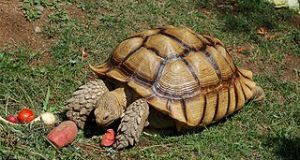The Red-Eared Slider (Trachemys scripta elegans) is without question the world’s most commonly-kept pet turtle. But while these attractive reptiles are extremely responsive to people, many novice owners underestimate the amount of care and space their upkeep requires…and do not realize that Sliders commonly live to age 20+, and often well beyond. Over time, these factors lead many people to release or re-home their once beloved pets. As a consequence, Sliders have become established, in the wild, in dozens of US states and in countries ranging from Brazil to South Africa and Japan, where they are causing ecological havoc. Turtle adoption services and reptile rescues house literally thousands more unwanted pets. Please read this article carefully before buying or adopting a Red-Eared Slider, and be sure to post any questions below. Please also see the linked articles on the care of Sliders, Map Turtles and similar species.
Aquarium Size and Upkeep
Female Sliders reach 8-12 inches in length. I personally measured one that was just over 12 inches long…and 11 ¾ inches wide! Males generally top out at 6 inches, but both sexes are very active, and will languish in cramped quarters. An adult female will require a 75-100 gallon aquarium, a commercial turtle tub, or a wading pool. Pairs rarely do well together, as the overly-amorous males constantly harass the objects of their desire with mating attempts.
Turtles are messy feeders and very hard on water quality. Powerful filters help, but even so partial or total water changes will be necessary. If a large plastic storage container is used as a home, it must be emptied and cleaned several times weekly.
Cost
With so many being up for adoption, Slider ownership might appear to be a good deal. But the initial purchase price of any reptile is generally the smallest of the related financial considerations. In addition to large and expensive aquariums and filters, Slider ownership entails electricity use, veterinary care, and the purchase of UVB bulbs and fixtures, heat bulbs and fixtures, water heaters, basking platforms, food, and mineral supplements.
Veterinary Care
Veterinarians willing to treat reptiles are difficult to find in many regions, although those experienced in turtle care are becoming more common. It is always a mistake to obtain a reptile of any kind before locating a veterinarian, or to imagine that even the hardy Slider will not require medical care at some point. Veterinary costs for reptiles are comparable to those charged for dog or cat care.
Longevity
Sliders routinely reach age 20 in captivity, and have the potential to live much longer. The published longevity record is 41 years, but I’m quite sure, judging from experience with related species, that there are some that have exceeded the half-century mark. That cute little hatchling you bought for your child may become your (much larger!) responsibility when she or he goes off to college.
Health Considerations
Salmonella bacteria, commonly present in turtle digestive tracts, can cause severe illness in people. Handling an animal will not cause an infection, as the bacteria must be ingested. Salmonella infections are easy to avoid via the use of proper hygiene, but are a serious concern for children and elderly or immune-compromised adults. Please speak with your family doctor and see the article linked below for further information.
Slider Alternatives
Several Map and Painted Turtle species share the Slider’s lifestyle, good nature and hardiness, but do not grow quite as large. Common Musk Turtles, Eastern Mud Turtles and a number of their relatives are even smaller, and do not need a source of UVB radiation. All make great pets, and become quite responsive to people. There are a great many other possibilities as well…please see the linked articles and post below for further information.
Further Reading
Common Musk Turtles in Captivity: the Perfect Pet Turtle
Slider, Map and Painted Turtle Care
 That Reptile Blog – Reptile, Amphibian and Exotic Pet Care and Information
That Reptile Blog – Reptile, Amphibian and Exotic Pet Care and Information








My wife and I have a very established 5000 gallon pond in our backyard in Southern California. We’ve recently became new parents to 4 adult (2 male / 2 female) Red Eared Sliders and they are loving their new home. 3 of the 4 come swimming up to my wife when it’s feeding time and we constantly see them basking in the sun. The temperature where we live is between 80 and 90 degrees during the day and lately it’s been dipping down into the high 50’s. My concern is that when we finally get “cold” weather …. 60’s in the day and high 40’s at night, it might be too cold for our Sliders. What do you recommend?
Don’t worry, your turtles will be fine. Red Eared Sliders are extremely hardy animals. In fact, here in Pennsylvania they are an invasive species, and our winter temperatures reach the single digits.
-Josh